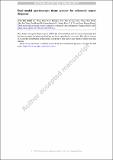Dual modal spectroscopic tissue scanner for colorectal cancer diagnosis
Author(s)
Yoon, Hong Man; Kim, Hongrae; Sohn, Dae Kyung; Park, Sung Chan; Chang, Hee Jin; Oh, Jae Hwan; Dasari, Ramachandra R.; So, Peter T. C.; Kang, Jeon Woong; ... Show more Show less
Download464_2020_7929_ReferencePDF.pdf (1.216Mb)
Open Access Policy
Open Access Policy
Creative Commons Attribution-Noncommercial-Share Alike
Terms of use
Metadata
Show full item recordAbstract
Abstract
Background
Margin status is an important prognostic factor for treating colorectal cancer. This study aimed to investigate the usefulness of a multimodal spectroscopic tissue scanner for real-time cancer diagnosis without tissue staining.
Patients and methods
Diffuse reflectance spectra (DRS) and fluorescence spectra (FS) of < 1-mm-sized paired cancer and normal mucosa tissue were acquired using custom-built spectroscopic tissue scanners. For FS, we analyzed wavelengths and intensities at peaks and highest intensities near (± 1.25 nm) the known fluorescence spectral peaks of collagen (380 nm), reduced nicotinamide adenine dinucleotide (NADH, 460 nm), and flavin adenine dinucleotide (FAD, 550 nm). For DRS, we performed a similar analysis near the peaks of strong absorbers, oxyhemoglobin (oxyHb; 414 nm, 540 nm, and 576 nm) and deoxyhemoglobin (deoxyHb; 432 nm and 556 nm). Logistic regression analysis for these parameters was performed in the testing set.
Results
We acquired 17,735 spectra of cancer tissues and 9438 of normal tissues from 30 patients. Intensity peaks of representative normal spectra for FS and DRS were higher than those of representative cancer spectra. Logistic regression analysis showed wavelength and intensity at peaks, and the intensities of the peak wavelength of NADH, FAD, deoxyHb, and oxyHb had significant coefficients. The area under the receiver operating characteristic curve was 0.927. The scanner had 100%, 64.3%, and 85.3% sensitivity, specificity, and accuracy, respectively.
Conclusions
The spectroscopic tissue scanner has high sensitivity and accuracy and provides real-time intraoperative resection margin assessments and should be further investigated as an alternative to frozen section.
Date issued
2020-09Department
Massachusetts Institute of Technology. Spectroscopy Laboratory; Massachusetts Institute of Technology. Laser Biomedical Research CenterJournal
Surgical Endoscopy
Publisher
Springer Science and Business Media LLC
ISSN
0930-2794
1432-2218
Keywords
Surgery